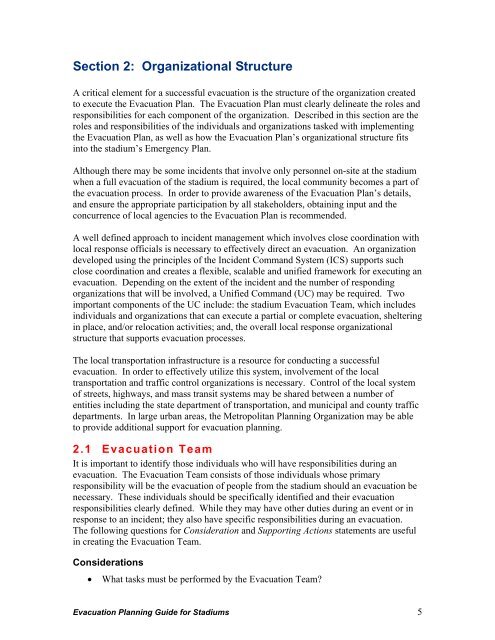Evacuation Planning Guide for Stadiums
Evacuation Planning Guide for Stadiums
Evacuation Planning Guide for Stadiums
Create successful ePaper yourself
Turn your PDF publications into a flip-book with our unique Google optimized e-Paper software.
Section 2: Organizational Structure<br />
A critical element <strong>for</strong> a successful evacuation is the structure of the organization created<br />
to execute the <strong>Evacuation</strong> Plan. The <strong>Evacuation</strong> Plan must clearly delineate the roles and<br />
responsibilities <strong>for</strong> each component of the organization. Described in this section are the<br />
roles and responsibilities of the individuals and organizations tasked with implementing<br />
the <strong>Evacuation</strong> Plan, as well as how the <strong>Evacuation</strong> Plan’s organizational structure fits<br />
into the stadium’s Emergency Plan.<br />
Although there may be some incidents that involve only personnel on-site at the stadium<br />
when a full evacuation of the stadium is required, the local community becomes a part of<br />
the evacuation process. In order to provide awareness of the <strong>Evacuation</strong> Plan’s details,<br />
and ensure the appropriate participation by all stakeholders, obtaining input and the<br />
concurrence of local agencies to the <strong>Evacuation</strong> Plan is recommended.<br />
A well defined approach to incident management which involves close coordination with<br />
local response officials is necessary to effectively direct an evacuation. An organization<br />
developed using the principles of the Incident Command System (ICS) supports such<br />
close coordination and creates a flexible, scalable and unified framework <strong>for</strong> executing an<br />
evacuation. Depending on the extent of the incident and the number of responding<br />
organizations that will be involved, a Unified Command (UC) may be required. Two<br />
important components of the UC include: the stadium <strong>Evacuation</strong> Team, which includes<br />
individuals and organizations that can execute a partial or complete evacuation, sheltering<br />
in place, and/or relocation activities; and, the overall local response organizational<br />
structure that supports evacuation processes.<br />
The local transportation infrastructure is a resource <strong>for</strong> conducting a successful<br />
evacuation. In order to effectively utilize this system, involvement of the local<br />
transportation and traffic control organizations is necessary. Control of the local system<br />
of streets, highways, and mass transit systems may be shared between a number of<br />
entities including the state department of transportation, and municipal and county traffic<br />
departments. In large urban areas, the Metropolitan <strong>Planning</strong> Organization may be able<br />
to provide additional support <strong>for</strong> evacuation planning.<br />
2.1 <strong>Evacuation</strong> Team<br />
It is important to identify those individuals who will have responsibilities during an<br />
evacuation. The <strong>Evacuation</strong> Team consists of those individuals whose primary<br />
responsibility will be the evacuation of people from the stadium should an evacuation be<br />
necessary. These individuals should be specifically identified and their evacuation<br />
responsibilities clearly defined. While they may have other duties during an event or in<br />
response to an incident; they also have specific responsibilities during an evacuation.<br />
The following questions <strong>for</strong> Consideration and Supporting Actions statements are useful<br />
in creating the <strong>Evacuation</strong> Team.<br />
Considerations<br />
• What tasks must be per<strong>for</strong>med by the <strong>Evacuation</strong> Team?<br />
<strong>Evacuation</strong> <strong>Planning</strong> <strong>Guide</strong> <strong>for</strong> <strong>Stadiums</strong> 5


